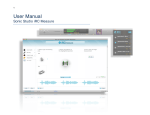Download Wisdom Sage SCS Owner`s manual
Transcript
Owner’s Manual Sage SCS Subwoofer WARNING: TO REDUCE THE RISK OF FIRE OR ELECTRIC SHOCK, DO NOT EXPOSE THIS APPLIANCE TO RAIN OR MOISTURE. CAUTION RISK OF ELECTRIC SHOCK DO NOT OPEN CAUTION: TO REDUCE THE RISK OF ELECTRICAL SHOCK, DO NOT REMOVE COVER. NO USER-SERVICEABLE PARTS INSIDE. REFER SERVICING TO QUALIFIED PERSONNEL. Danger The lightning flash with arrowhead symbol, within an equilateral triangle, is intended to alert the user to the presence of uninsulated “dangerous voltage” within the product’s enclosure that may be of sufficient magnitude to constitute a risk of electric shock to persons. Important The exclamation point within an equilateral triangle is intended to alert the user to the presence of important operating and maintenance (servicing) instructions in the literature accompanying this equipment. Marking by the “CE” symbol (shown left) indicates compliance of this device with the EMC (Electromagnetic Compatibility) and LVD (Low Voltage Directive) standards of the European Community. Note: This equipment has been tested and found to comply with the limits for a Class B digital device, pursuant to part 15 of the FCC Rules. These limits are designed to provide reasonable protection against harmful interference in a residential installation. This equipment generates, uses and can radiate radio frequency energy and, if not installed and used in accordance with the instructions, may cause harmful interference to radio communications. However, there is no guarantee that interference will not occur in a particular installation. If this equipment does cause harmful interference to radio or television reception, which can be determined by turning the equipment off and on, the user is encouraged to try to correct the interference by one or more of the following measures: • Reorient or relocate the receiving antenna • Increase the separation between the equipment and the receiver • Connect the equipment into an outlet on a circuit different from that to which the receiver is connected • Consult the dealer or an experienced radio/TV technician for help 2 Important Safety Instructions Please read all instructions and precautions carefully and completely before operating your Wisdom Audio equipment. 1. Read these instructions. 2. Keep these instructions. 3. Heed all warnings. 4. Follow all instructions. 5. Do not use this equipment near water. 6. Clean only with a dry cloth. 7. Do not block any ventilation openings. Install in accordance with the manufacturer’s instructions. 8. Do not install near any heat sources such as radiators, heat registers, stoves, or other apparatus (including amplifiers) that produce heat. 9. Do not defeat the safety purpose of the polarized or grounding-type plug. A polarized plug has two blades with one wider than the other. A grounding type plug has two blades and a third grounding prong. The wide blade of the third prong are provided for your safety. If the provided plug does not fit into your socket, consult an electrician for replacement of the obsolete outlet. 10. Protect the power cord from being walked on or pinched particularly at plugs, convenience receptacles, and the point where they exit from the apparatus. 11. Only use attachments/accessories specified by the manufacturer. 12. Unplug this apparatus during lightning storms or when unused for long periods of time. 13. Refer all servicing to qualified personnel. Servicing is required when the apparatus has been damaged in any way, such as a power-supply cord or plug is damaged, liquid has been spilled or objects have fallen into the apparatus, the apparatus has been exposed to rain or moisture, does not operate normally, or has been dropped. 14. ALWAYS disconnect your entire system from the AC mains before connecting or disconnecting any cables, or when cleaning any component. 15. NEVER operate this product with any covers removed. 16. NEVER wet the inside of this product with any liquid. 17. NEVER pour or spill liquids directly onto this unit. 18. NEVER bypass any fuse. 19. NEVER replace any fuse with a value or type other than those specified. 20. NEVER operate this product in an explosive atmosphere. 21. ALWAYS keep electrical equipment out of the reach of children. 3 Table of Contents Important Safety Instructions..........................................................................3 Introduction.....................................................................................................6 About this manual...................................................................................................6 Please register your system.....................................................................................6 Description......................................................................................................7 Regenerative Transmission Line™............................................................................7 Unpacking the SCS...........................................................................................8 Room Acoustics & Placement...........................................................................9 Start With the Room...............................................................................................9 Rigid Walls.......................................................................................................9 Speaker Placement................................................................................................10 Left & Right Speakers.....................................................................................10 Center Channel..............................................................................................10 Remote Setup via Modem.....................................................................................10 Surround Speakers......................................................................................... 11 Subwoofer Placement........................................................................................... 11 Room Treatment...................................................................................................12 Professional Acoustic Design................................................................................12 References............................................................................................................12 Rear Panel......................................................................................................14 Remote turn-on tip polarity............................................................................17 Setting Up the SCS.........................................................................................18 Using the Wisdom Audio SC-1..............................................................................18 Using a Surround Processor..................................................................................18 Using a Stereo Preamplifier...................................................................................18 North American Warranty.............................................................................20 Five Year Warranty...............................................................................................20 Obtaining Service..........................................................................................21 Specifications.................................................................................................22 SCS Dimensions.............................................................................................23 Notes..............................................................................................................24 Introduction Congratulations on purchasing your Wisdom Audio SCS subwoofer. The Regenerative Transmission Line™ technology used in the SCS delivers tremendous bass performance in terms of depth, dynamics, and low distortion resulting in articulate bass that integrates seamlessly with high-resolution main speakers such as Wisdom Audio’s Sage Series. About this manual Please register your system This manual focuses on the SCS subwoofer itself. While we expect your local Wisdom Audio dealer to take care of the setup and calibration of the system, we still recommend that you at least briefly review this and the other Wisdom Audio manuals relevant to your system (SC-1, SA-series amplifiers, other Sage speakers) to understand the system’s full capabilities. To register your warranty, please complete the form at the following address on the internet: http://www.wisdomaudio.com/registration/ Doing so will ensure that there will be no delays should you ever require warranty service. If accessing the internet is inconvenient, you can send a copy of the sales receipt (showing your name, address and the products purchased) to the address shown in the North American Warranty section of this manual. Wisdom Audio does not and will not ever share its mailing list with other companies. Nor do we expect to contact you frequently, since you are buying a product that should last a lifetime. However, we would like to be in a position to contact you should a software update become available for the system controller (as an example). Lastly, please keep your sales receipt in a safe and easily found place. If you do not register your purchase with the company, it is your only proof of warranty. 6 Description Your Sage SCS subwoofer uses a modern implementation of an old idea for high quality, low distortion bass reproduction. While the roots of the Regenerative Transmission Line™ go back to the 1950’s, it is the combination of modern computer modeling and the vastly more powerful motors of contemporary driver design that make the RTL™ so special. Regenerative Transmission Line™ There is a class of bass enclosures that has been around since the 1950’s, which can be described generically as “low frequency tapped waveguides” or “tapped pipes.” It was an idea that was a bit ahead of its time then, since fully optimizing its use required both powerful drivers and computer modeling. But if you are into such things, check out US Patent 2,765,864 (filed in 1955), and an AES paper published in 1959, “Analysis of a Low Frequency Loudspeaker System.” We have published both on our website for your convenience, at http://www.wisdomaudio.com/support_documents.php We have utilized sophisticated modeling software in order to fully optimize our enclosures, and have developed drivers that are specifically optimized for this application. We call our unique implementation of this relatively old idea a “Regenerative Transmission Line™” subwoofer, or “RTL” sub for short. All dynamic drivers develop energy on both sides of the diaphragm, with the rear energy being 180° out of phase with the front energy. If you allow the driver to operate in free space (no enclosure), the front and rear energies largely cancel each other out — especially at low frequencies. In our Regenerative Transmission Line™ subwoofer, the energy from the back side of the driver is sent along a long, folded path in such a way that its lowest frequencies arrive back at the front side of the driver in phase, effectively summing to an increase of 6 dB in output. Thus, the energy from both sides of the woofer cone is used in a productive way, resulting in a substantial reduction in distortion and an effective surface area that is twice what you would otherwise expect. As an example, the effective radiating surface area in the SCS is roughly equivalent to a 13” diameter round woofer, yet the enclosure is only about 7” wide. The results are quite stunning. Low frequencies are strikingly dynamic and responsive, and integrate quite seamlessly with the fast and detailed Sage Series planar magnetic hybrids. As an example, the SCS is easily hidden behind a sofa, or within a set of risers in a dedicated home theater, yet is only –3 dB at 20 Hz and can output in excess of 120 dB at 22 Hz (measured at its output port to minimize the room’s effects on the measurement). 7 Unpacking the SCS The Wisdom Audio Sage SCS subwoofer is a substantial piece of equipment. Please exercise caution when unpacking your SCS to ensure that you do not strain yourself from its (perhaps unexpected) weight. Caution! Do not attempt to lift your SCS by yourself. Unpacking this subwoofer is easy for two people, but it is unwise for a single person to attempt doing so. Do not attempt to lift your SCS while bending or twisting from the waist. Use your legs for lifting, not your back. Always stand as straight as possible and keep the SCS close to your body to reduce strain on your back. The SCS is fully assembled on delivery, and preset for 230V operation. If your AC mains service is 115/120V (as is the case in North America), slide the voltage selection switch to “115” prior to plugging in the power cord. See page 17: “AC Mains Voltage Selector”. 8 Room Acoustics & Placement Wisdom Audio believes in implementing room equalization to achieve a higher level of realism and fidelity. Assume for a moment that you had a “perfect” loudspeaker: as soon as you place it in your room, its perfection is gone. In fact, even good rooms often introduce deviations of 20 dB to the response of the system. This is particularly true in the bottom two octaves, where a subwoofer operates. It seems strange to us to worry about tenths-of-a-decibel differences between one component and another when there are 10-20 dB problems right there in the room with you. At the same time, room equalization is not a panacea. It does not solve all problems. In fact, and somewhat paradoxically, EQ works best when it has the least to do. It is best used as the “finishing touch” on an otherwise good system. Unfortunately, most people do not understand that the most important component in their system is their listening room. This manual does not have the space for a full description of everything that goes into creating excellent room acoustics; doing so would require a textbook of several hundred pages. Instead, we will give you some ideas, and some references to pursue should you want to learn more. Start With the Room There are many myths floating around pertaining to what a “good room” should be like. One of the most common is that it should have non-parallel walls. Without going into the details, we recommend staying with rectangular rooms whose dimensions do not share common divisors. Thus a room with dimensions of 8’ by 16’ by 20’ would be quite poor (since the dimensions are all divisible by a length of 4’, and 16 is also a multiple of 8). By contrast, a room whose dimensions are 9’ by 16’ by 29’ would be much better, since none of the dimensions are mathematically related to one another. There are infinite variations on this idea. If you have the flexibility to choose (or modify) your room dimensions to avoid such problems, do so. Either way, our room correction will be a big help. Rigid Walls Another myth that should be dispelled is the notion that the walls (and ceiling and floor) of the room should be extremely rigid in order to reproduce good bass. Rigid, inflexible walls reflect energy extremely well; thus you will keep more of the bass energy in the room. This much is true. However, those rigid walls will only increase the amplitude of the standing waves that your room naturally supports. In simple terms, you will have more bass, but it will also be more irregular, with larger peaks and valleys in the response. Walls that flex a bit (but do not rattle) are much better. Coincidentally, traditional American residential construction standards (sheet rock on wooden studs) are not a bad place to start. You can do better still with professional help, but studs and sheet rock are better than poured concrete. (If your listening room is in the basement, a false wall can easily be built in front of the concrete. You probably need something like this for insulation and aesthetics anyway.) 9 The ultimate in dedicated listening room construction involves the design and construction of floating walls, ceiling and floor. This approach yields the added benefit (when done properly) of providing outstanding acoustic isolation from adjacent spaces as well as superb bass reproduction. This approach goes well beyond the scope of an owner’s manual; if you are interested, you should contact a professional acoustician who has specialized in this sort of domestic room design. Speaker Placement Within the room itself, placement of the speakers and the listener will have a profound effect on the performance of the system, particularly below 300 Hz or so. There is no “perfect” position that will solve all problems, but finding the best compromise will make it easier to solve the remaining problems with the SC-1. Your Wisdom Audio dealer can help you with optimizing your speaker placement, which is never quite as simple as it seems it should be. The characteristics you should listen for are several: Left & Right Speakers Goal #1: Stable, 3-dimensional stereo imaging This usually requires reasonable symmetry within the room, and a bit of space between the speakers and adjacent side walls (to minimize the adverse effects of early first reflections). Mono (correlated) pink noise can help here, though it does not replace listening to music. With pink noise playing in both speakers, you should hear a tightly-defined little “ball” of pink noise floating in space exactly halfway between the speakers. Goal #2: Smooth, consistent bass Oft-cited rules of thumb for smoother bass reproduction include both “placing the speakers at different distances from the side walls vs. the wall behind them,” and “placing them at ‘odd fractions’ of the room’s dimensions” (e.g., fractions in which the denominator is an odd number, like 1⁄ 3, 2⁄5, 2⁄ 7, etc.). But nothing replaces your experience in your room, combined with your dealer’s experience in a variety of rooms. Playing pink noise through the woofer sections of your Wisdom Audio speakers (with the microphone at the listening position, and prior to doing any equalization) and watching the results on a Real Time Analyzer (RTA) will let you see the results of your labors. Center Channel Center channel height Once you have a solid stereo image up front (when listening only to the Left and the Right speakers), you need a center channel speaker for multichannel reproduction. It should be centered between the Left and Right, and centered on the screen’s location, preferably at the same height as the Left and Right speakers. This presents an obvious problem: you cannot place a speaker in front of your television screen. Ideally, a center channel speaker would be behind an acoustically transparent front projection screen and would match the Left and Right speakers. Doing so would ensure the best possible consistency of tonal balance, image height, and dynamic capabilities for the critical center channel. Failing an acoustically transparent screen or a phantom center channel approach, the important thing is to match the tonal and dynamic capabilities of the Left and Right speakers while minimizing the change in image height as a sound is panned across the front stage. 10 Surround Speakers Surround channel geometry In a 5.x channel system, the surround should be placed either directly to the sides of or slightly behind the listening area (90°–110° from the center channel, as seen from above). In a 7.x system, the surround speakers should be closer to 90° from the center speaker, and the surround back speakers should be at approximately 135°–150° from the center speaker. This conforms to industry standards, and ensures that you hear what was intended from a spatial placement point of view. (Too often, the surround speakers are all behind the listeners, creating a big “hole” in the soundfield between the front and the back.) L Sub 1 R C 0° 22° 30° Sub 2 90° Ls Rs 110° 135° Lb 150° Rb a 7.2 channel system layout One possible exception to these guidelines: if you have a THX®-certified processor and are using the THX Advanced Speaker Array™ circuitry, you should follow the guidelines in your owner’s manual for the processor. Using this technology, it can actually be more effective to have the rear speakers in a 7.x system directly behind you and immediately adjacent to each other. Subwoofer Placement Subwoofers offer somewhat greater flexibility in placement, since the frequencies they reproduce are not readily localizable by the human ear. This is due to the fact that the wavelengths they reproduce are more than ten feet (3 meters) long, but our ears are located only about 6-7 inches (17 cm) apart. Thus these extremely long waves do not contribute meaningfully to the imaging that the main speakers create. However, this fact does not mean that the placement of the subwoofers has no effect on the sound quality in the room. Far from it. The subwoofers are the most likely to suffer from the response irregularities introduced by the room itself, operating as they do below approximately 80 Hz in most systems. Recent research into the behavior of rooms as a function of speaker placement has concluded that — if you have the freedom to do so — there are significant advantages to placing several smaller subwoofers around the room, rather than relying on a single large woofer. Moreover, the optimum placement is usually centered on each of the four walls, or deep in the corners of the room. If you have the luxury of doing so, this simple placement strategy can reduce the size of the room’s response irregularities from 20 decibels down to perhaps as little as 6-8 decibels—a tremendous improvement. 11 Reducing the room’s inherent problems to this degree provides a huge advantage. It allows the SC-1 System Controller to put its considerable abilities to work on perfecting your system’s response, rather than on trying to perform major corrective surgery. Room Treatment Rectangular rooms have six reflecting surfaces (four walls, ceiling and floor) that reflect sound to the listener, after various delays introduced by the indirect routes the sounds take on their way to the listener. These first reflections are particularly damaging to sound quality. Looking at the simplest case of stereo reproduction, you have a minimum of twelve first reflection points in your room that deserve some attention. Unfortunately, it is often difficult to do much about the ceiling and floor reflections, even though they are arguably the most destructive. (The minimization of these reflections is one of the strongest arguments for the tall, line source loudspeakers that Wisdom Audio builds.) This leaves you with eight “first reflections” that you should consider minimizing somehow. These points are easily found by having an assistant slide a small mirror along the four walls of the room, while you sit at the listening position. Any place on the wall where you can see a reflection of any speaker is a first reflection point. Concentrate on the first reflections for the Left and Right speakers first. If you can, arrange to apply either absorption or diffusion at these eight points (don’t forget the wall behind you). Absorption can be as simple as heavy, insulated drapes; diffusion can be provided by a well-stocked bookcase with books of varied sizes. Alternatively, you can buy purpose-designed room treatments (some sources listed under References, below). The important things to remember are these: a good room should have a balance of absorption and diffusion; and if you are going to treat only a few areas of the room, the first reflection points are the most important ones to treat. Professional Acoustic Design Does this all sound too complicated? For good reason: it is complicated. The difference between the average listening room and one that is professionally designed and implemented is huge. A great listening room will disappear to an astonishing degree, letting the experiences captured in your recordings speak to you directly. A well-designed room is also quieter and more comfortable. It can easily become a favorite retreat for peace and rejuvenation. If you decide to investigate the possibility of improving your room with the help of a professional, it is important to find someone who focuses on residential spaces. Most acousticians are trained to deal with large spaces — airports, auditoriums, lobbies in commercial buildings, etc. The problems seen in “small” rooms (residential spaces) are quite different, and outside the experience of most acousticians. Find someone who specializes in and has a great deal of experience designing home studios, home theaters, and the like. Your Wisdom Audio dealer may be such a person; failing that, he/she can help you find such a professional. References 12 Books on Acoustics: The Master Handbook of Acoustics, F. Alton Everest, TAB Books Sound Reproduction: The Acoustics and Psychoacoustics of Loudspeakers and Rooms by Dr. Floyd Toole, Focal Press Suppliers of Acoustic Treatments: Acoustic Innovations, http://www.acousticinnovations.com/ Acoustic Sciences Corporation, http://www.acousticsciences.com/ Echo Busters, http://www.echobusters.com MSR Acoustics, http://www.msr-inc.com/home_theater/hometheater.html RPG Diffusor Systems, http://www.rpginc.com/ 13 Rear Panel Danger! Potentially dangerous voltages and current capabilities exist within your SCS subwoofer. Do not attempt to open any portion of the SCS’s cabinet. There are no user-serviceable parts inside your SCS. All service of this product must be referred to a qualified Wisdom Audio dealer or distributor. 1. Output Level Control When using the Left and Right inputs, this flush-mounted control adjusts the volume of the SCS over a wide range. Use it to establish a volume for the SCS that matches the volume of the main speakers. This control is bypassed when using the SSP/Direct input, since the volume control function is handled by the surround sound processor. 2. 14 Polarity Switch Use this sliding switch to invert the polarity of the SCS as needed to integrate properly with your main speakers. t Caution! Always turn off the main power and wait a few seconds for the power supply to discharge before changing the position of the polarity switch. If you are in doubt as to which position (0° or 180°) is the correct one for your system, play some material with significant energy at and around your chosen crossover frequency. Pink noise will also work. Then listen to the system with both the SCS and the main speakers playing. The position with more energy at the chosen crossover region (e.g., the position that sounds louder or more “full”) is the correct position. 3. Balanced (XLR) Inputs Three XLR input connectors are provided, as follows: • SSP/Direct: for use with a surround sound processor/preamplifier. This input bypasses both the internal crossover and level control of the SCS, since both of these functions are handled by the SSP. • Left & Right: for use in systems that lack any bass management (as would be provided by a surround processor). For example, you can run the Left and Right outputs of a traditional stereo preamplifier into these inputs, and then set the crossover frequency and subwoofer level on the SCS itself. If your preamplifier does not have multiple outputs, use a Y-adapter to send the same full-range signal to both the SCS and the power amplifier for the main speakers. Balanced interconnects are less susceptible to picking up noise than are single-ended interconnects. As such, if your system gives you the choice of using either balanced or single-ended connections, the balanced (XLR) connections are preferred. 4. Single-Ended (RCA) Inputs Three RCA input connectors are provided, as follows: • SSP/Direct: for use with a surround sound processor/preamplifier. This input bypasses both the internal crossover and level control of the SCS, since both of these functions are handled by the SSP. • Left & Right: for use in systems that lack any bass management (as would be provided by a surround processor). For example, you can run the Left and Right outputs of a traditional stereo preamplifier into these inputs, and then set the crossover frequency and subwoofer level on the SCS itself. If your preamplifier does not have multiple outputs, use a Y-adapter to send the same full-range signal to both the SCS and the power amplifier for the main speakers. 5. Crossover Frequency Control When using the Left and Right inputs, this flush-mounted control adjusts the crossover frequency of the low pass filter in the SCS between 50-80 Hz. Use it to establish a smooth transition from the SCS to your main speakers. 15 This control is bypassed when using the SSP/Direct input, since the crossover function is handled by the surround sound processor. 6. Power Switch An AC mains switch is located above the power cord on the rear panel of the SCS. This switch may be used to disconnect the unit from the AC mains without having to actually unplug the SCS from the wall outlet. If you plan to be away for an extended period, or have any other reason to turn the SCS completely off, you may either unplug the SCS or you may use the AC mains switch. Important! As with all your electronics, we suggest you completely disconnect the SCS from the AC mains during severe electrical storms. 7. Warning! AC Mains Input A 15-ampere IEC standard power cord is used with the SCS. A high quality 15-ampere AC mains cord is included with the product, although the use of the standardized IEC receptacle means that you may easily substitute another high quality AC mains cord if you wish. Your new Wisdom Audio SCS has been safety-tested and is designed for operation with a three-conductor power cord. Do not defeat the “third pin” or earth ground of the AC power cord. We recommend that care be taken to ensure that all AC plugs for the equipment in the system be wired so as to ensure proper AC polarity. Doing so will minimize noise in the system. In the U.S., a simple AC mains tester (found at any hardware store) can test to ensure that your electrical outlets are wired properly. Elsewhere in the world (for example, in European Union countries), the AC mains plugs themselves are not always polarized. Your dealer can test for the proper orientation of the plug in the outlet. In such a case, it is good practice to mark both plug and outlet to ensure that all products remain in the proper orientation should it become necessary to temporarily disconnect the system (as for example, during an electrical storm). 8. Standby/Operate Indicator This LED indicator glows green when the SCS has power and is in Operate mode. If the SCS is placed into Standby by means of the DC Trigger, the output will be muted and this LED will glow red. If this LED is not lit at all, no power is reaching the SCS. Check the power switch, the power cord, and the circuit into which the SCS is plugged. 9. 16 DC Trigger Input This 12v trigger input provides compatibility with a wide range of products to facilitate remote turn-on and turn-off in systems. These 1⁄8” (3.5 mm) “mini-jacks” allow other components to bring the SCS in and out of standby. The remote trigger input will be operated by any positive-polarity DC signal between 3–20 volts (only a few milliamps are required), with tip polarity as shown below: Remote turn-on tip polarity – + InputSignal:3-20volts@lessthan10mA OutputSignal:12volts@100mA If no plug is inserted in the DC Trigger input, the SCS will remain in the Operate mode unless turned off by the power switch. Inserting either a “dummy” plug or a trigger that has 0V on it will place the SCS into Standby; it will return to Operate when the voltage on the plug reaches the 3-20V range, or when the plug is removed. Your Wisdom Audio dealer can help you take advantage of these design features to maximize your system’s convenience and versatility. 10. AC Mains Voltage Selector This switch reconfigures the SCS for either 115V or 230V operation. Warning! NEVER change the position of this switch while the SCS is connected to AC mains power. If you need to change the operating voltage for the SCS, disconnect it completely from the AC mains, and wait for a few seconds for its power supply to discharge. Then slide the switch all the way to the other position. Only then should you reconnect the AC mains. 17 Setting Up the SCS The unusual form factor of the SCS allows it to be used effectively in many situations where a more conventional “bass cube” would be either cumbersome or impossible. Examples include locating it behind a couch, in the small space between the couch and the wall, or laying flat under a set of risers in a home theater with multiple rows of seating. The SCS also includes three locations for the exit of the Regenerative Transmission Line™. As shipped from the factory, the vent is located on the end of the SCS enclosure. However, if your location would be better served by the vent being on one side or the other, your dealer can easily swap the grille for the solid aluminum plate that covers the desired exit location. There is no difference in performance, but often a great difference in application flexibility. Using the Wisdom Audio SC-1 Using a Surround Processor When using the SCS with the SC-1 System Controller, connect the appropriate Sub Output of the SC-1 to the balanced SSP/Direct input of the SCS. Then calibrate the system as usual, using Wisdom System Configuration and Audyssey MultEQ Pro. When using the SCS in a multichannel system with a surround preamp/processor, connect the appropriate Sub output from the SSP to the SSP/Direct input. Calibrate the system as you normally would, following the directions provided by the owners’ manual for the surround processor. The internal crossover and level controls of the SCS are bypassed when using this input, so your surround processor has complete control over what the subwoofer is given to do. Using a Stereo Preamplifier The somewhat tricky setup is when you use the SCS (or any subwoofer, for that matter) with a traditional stereo preamplifier that lacks any of the bass management capabilities found in surround processors. As a reminder, you should run both the Left and Right channel, full-range signals to the SCS, using the Left and Right inputs, respectively. This can be accomplished either by using a second set of outputs from your preamplifier, or by using a pair of Y-adapters to split each channel into two identical copies (the other of which goes to the main amplifier for your regular speakers). Optimizing the system in such cases involves a bit of trial and error, but it is usually a fairly interesting and pleasant experience. The goal is to achieve a smooth transition from the SCS to your main speakers that is seamless. If you have a high resolution RTA (real time analyzer) and some pink noise, you can “rough in” the settings fairly quickly. But even so, you will want to do the final adjustment by ear, using music as your guide. Find some music that has consistent energy in the 40-80 Hz octave. (An acoustic recording of a solo upright bass player works well). Then: 18 1. Turn both the Crossover Frequency and Output Level controls all the way down. This will reduce the audible contribution of the SCS to the point of being negligible. 2. While playing your 40-80 Hz music, slowly raise the Output Level control until the bass seems just a bit too prominent, then back it off slightly. The goal here is to roughly match the overall level of the SCS to the overall level of your main speakers. You probably won’t get it just right on the first try; you just need to get it close. 3. Next, slowly raise the crossover frequency until the midbass begins to sound a bit “thick.” Lower the crossover frequency just until the “thick” quality goes away. The “thickness” you hear is an indication that the SCS and your main speakers are beginning to overlap, creating an excess of energy in the overlap region. Back it off until the transition from one to the other is done more smoothly. 4. Return to the Output Level control, and fine-tune the volume of the SCS now that the transition to the main speakers is better-defined. You may find you need to go back and forth between these two adjustments a couple times, since it is an iterative adjustment by its nature. When properly adjusted and listening to music, you should not be aware that the SCS is active in the system (until you turn it off and realize how much it has been contributing). The proper level setting will allow the SCS to integrate quite seamlessly into a high quality system. 19 North American Warranty Five Year Warranty When purchased from and installed by an authorized Wisdom Audio dealer, Wisdom Audio® loudspeakers are warranted to be free from defects in material and workmanship under normal use for a period of five years from the original date of purchase. During the warranty period, any Wisdom Audio loudspeaker exhibiting defects in materials and/or workmanship will be repaired or replaced, at our option, without charge for either parts or labor, at our factory. The warranty will not apply to any Wisdom Audio loudspeaker that has been misused, abused, altered, or installed and calibrated by anyone other than an authorized Wisdom Audio dealer. Any Wisdom Audio loudspeaker not performing satisfactorily may be returned to the factory for evaluation. Return authorization must first be obtained by either calling or writing the factory prior to shipping the component. The factory will pay for return shipping charges only in the event that the loudspeaker is found to be defective as mentioned above. There are other stipulations that may apply to shipping charges. There is no other express warranty on this loudspeaker. Neither this warranty nor any other warranty, express or implied, including any implied warranties of merchantability or fitness, shall extend beyond the warranty period. No responsibility is assumed for any incidental or consequential damages. Some states do not allow limitations on how long an implied warranty lasts and other states do not allow the exclusion or limitation of incidental or consequential damages, so the above limitation or exclusion may not apply to you. This warranty gives you specific legal rights, and you may also have other rights which vary from state to state. This warranty is applicable in North America only. Outside of North America, please contact your local, authorized Wisdom Audio distributor for warranty and service information. To register your warranty, please complete the form at the following address on the internet: http://www.wisdomaudio.com/registration/ Doing so will ensure that there will be no delays should you ever require warranty service. If accessing the internet is inconvenient, you can send a copy of the sales receipt (showing your name, address and the products purchased) to: Wisdom Audio 1572 College Parkway, Suite 164 Carson City, NV 89706 For more information: www.wisdomaudio.com [email protected] Ph: 775.887.8850 Fax: 775.887.8820 20 Obtaining Service We take great pride in our dealers. Experience, dedication, and integrity make these professionals ideally suited to assist with our customers’ service needs. If you develop a problem with your Wisdom Audio subwoofer, please contact your dealer. Your dealer will then decide whether the problem can be remedied locally, or whether to contact Wisdom Audio for further service information or parts. The Wisdom Audio Service Department works closely with your dealer to solve your service needs expediently. Important! Return authorization must be obtained from Wisdom Audio’s Service Department BEFORE a unit is shipped for service. It is extremely important that information about a problem be explicit and complete. A specific, comprehensive description of the problem helps your dealer and the Wisdom Audio Service Department locate and repair the difficulty as quickly as possible. 21 Specifications All specifications are subject to change at any time, in order to improve the product. ■ ■ ■ ■ ■ ■ Frequency Response 20 – 80 Hz ± 3dB relative to the target curve Maximum Output (at one meter in 1⁄4 space) 113 dB @ 24 Hz Maximum Output (at one foot in 1⁄4 space) 122 dB @ 24 Hz Rated Power 400W Mains voltage: Dimensions ■ Power consumption: ■ Shipping weight 100/120V, or 230/240V 7” by 22.5” by 37” 17.8 cm by 57.15 cm by 94 cm 575W (±5%) at full power 72 lbs. (33 kg) For more information, see your Wisdom Audio dealer, or contact: Wisdom Audio 1572 College Parkway, Suite 164 Carson City, NV 89706 www.wisdomaudio.com [email protected] Ph: 775.887.8850 Fax: 775.887.8820 22 SCS Dimensions 23 Notes 24 25 WISDOM and the stylized W are registered trademarks of Wisdom Audio. Wisdom Audio 1572 College Parkway, Suite 164 Carson City, Nevada 89706 USA Telephone: 775.887.8850 Fax: 775.887.8820 SCSOM-1.02 26 © 2/2010 Wisdom Audio, Inc. All rights reserved. Printed in U.S.A.









































